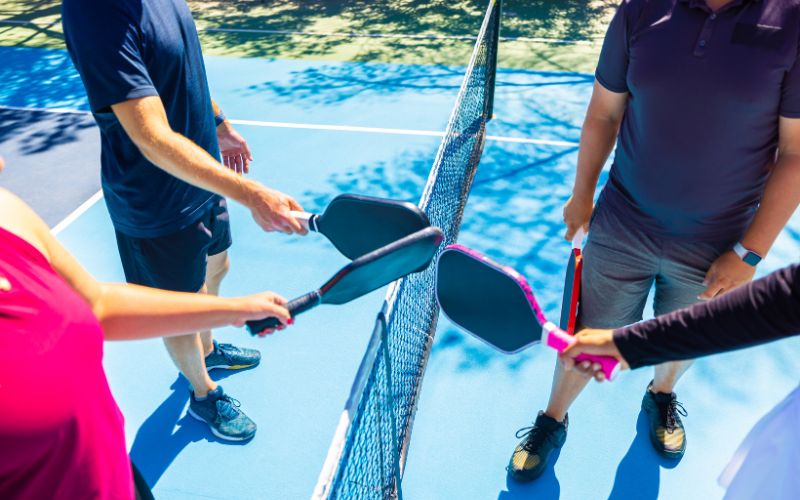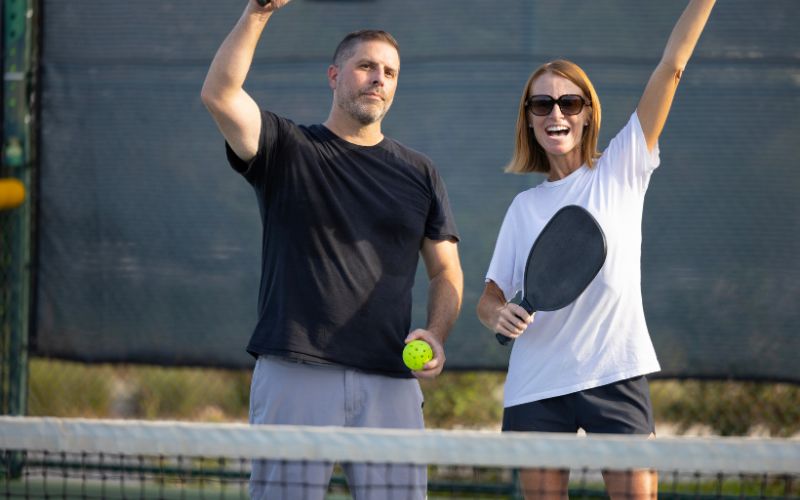Pickleball, a popular racket sport blending elements of tennis, badminton, and ping pong, has gained traction due to its fast-paced gameplay and accessibility for players of various skill levels. A frequently debated topic among pickleball enthusiasts is whether one can switch hands while playing. Let’s delve into this query and explore the nuances of hand switching in pickleball.
Switching Hands in Pickleball
Common reasons why players might opt to switch hands during a pickleball game:
1. Injury Prevention or Rehabilitation
Shoulder injuries or other physical limitations might prompt players to switch hands in pickleball. For instance, if a player sustains a minor injury to their dominant arm or shoulder, they might temporarily switch to their non-dominant hand to continue playing while allowing the injured side to recover.
2. Extreme Defensive Reach
During intense rallies or when stretching to reach shots on the court, players might find that using their non-dominant hand provides an extra reach or flexibility, allowing them to access shots that would be challenging to reach with their dominant hand. This can help in defensive play, preventing opponents from gaining an advantage.
3. Surprising or Shocking the Opponent
Strategic hand switching can disrupt an opponent’s expectations and rhythm during a match. By suddenly switching hands, a player may catch their opponent off guard, potentially leading to a misjudgment or forcing the opponent into making errors due to the unexpected change in shot trajectory or pace.
4. Learning a Two-Handed Backhand Technique
Some players opt to switch hands as part of their strategy to develop a proficient two-handed backhand. While not everyone prefers this technique, mastering a two-handed backhand involves practicing and alternating between hands during gameplay. This approach allows players to gradually strengthen their weaker side and develop a versatile playing style.
What Constitutes Switching Hands in Pickleball?
In the context of pickleball, switching hands refers to the act of transitioning the paddle from your dominant hand to your non-dominant hand or vice versa during a rally or between shots. This maneuver can offer players a fairly unique advantage in certain situations.
The Advantage of Hand Switching in Pickleball
Pickleball players, especially those with ambidextrous tendencies or a proficient non-dominant hand, may consider switching hands to gain a better position on the court or to execute shots more effectively, particularly if they possess a weak backhand on their dominant side.
Switching hands enables players to access a wider range of shots, providing an increased reach and allowing them to hit the ball with their stronger hand in specific scenarios, thus potentially gaining an edge over opponents.
Can Players Switch Hands According to Pickleball Rules?
In pickleball, the rules don’t explicitly prohibit players from switching hands during a rally. However, executing this maneuver requires practice and skill to ensure a seamless transition without violating the rules or impeding the flow of the game.
Considerations for Hand Switching While Playing Pickleball
Players attempting to switch hands should focus on maintaining proper technique to avoid mishits or errors. Practice is essential to smoothly switch the paddle from one hand to another, especially during fast exchanges or intense rallies.
- Grip: A comfortable and adaptable grip is crucial for swift hand changes.
- Technique: Mastering the technique for efficient hand switching can significantly impact gameplay.
- Opponent Awareness: Assess the situation and your opponent’s positioning before attempting a hand switch.
Tips to Consider When Attempting to Switch Hands During a Pickleball Game:
1. Practice Regularly
- Dedicated Practice Sessions: Allocate time specifically to practice switching hands. Start with slow, deliberate movements and gradually increase the speed as you become more comfortable.
- Repetition is Key: Consistent practice improves muscle memory, making it easier to switch hands seamlessly during gameplay.
2. Develop a Comfortable Grip
- Adaptable Grip: Maintain a grip that allows you to transition the paddle smoothly between hands. Experiment with various grips to find what works best for you.
- Secure Hold: Ensure the paddle is firmly gripped in both hands to prevent mishits or accidental drops during the transition.
3. Technique Matters
- Smooth Transition: Practice transitioning the pickleball paddle between hands smoothly and swiftly without disrupting your gameplay or the rhythm of the rally.
- Stance and Balance: Maintain a balanced stance while switching hands to remain stable and ready to react to the next shot.
4. Strategic Considerations
- Assess the Situation: Evaluate the rally’s pace, your opponent’s positioning, and the type of shot you’re about to receive or deliver before deciding to switch hands.
- Pick the Right Moment: Avoid switching hands during high-speed exchanges or critical moments unless you are confident in your ability to execute the switch without compromising your gameplay.
5. Awareness of Opponent Movements
- Observation: Stay aware of your opponent’s movements and positioning to anticipate their shots and adjust your hand switching accordingly.
- Surprise Element: Use hand switching strategically to surprise your opponent and potentially gain a momentary advantage.
6. Patience and Persistence
- Be Patient: Mastery of hand switching takes time, so be patient with yourself and continue practicing to improve your technique gradually.
- Learn from Mistakes: Don’t get discouraged by mishits or errors initially. Learn from these experiences to refine your hand switching skills.
In the dynamic realm of pickleball, the ability to switch hands during gameplay offers players a strategic edge, allowing for increased versatility and adaptability on the court. Whether it’s to gain a tactical advantage, accommodate physical limitations, surprise opponents, or develop diverse playing techniques, hand switching remains a debated yet potentially rewarding aspect of pickleball strategy.
Frequently Asked Questions (FAQs)
Are players allowed to switch hands in the middle of a pickleball game?
Yes, according to pickleball rules, players can switch hands during a rally or between shots without violating any regulations.
How can switching hands benefit a pickleball player?
Switching hands provides players with an increased reach, the ability to hit shots with their stronger hand in crucial moments, and the potential to surprise opponents, thereby gaining a strategic advantage.
Is it challenging to switch hands during a fast-paced pickleball rally?
Initially, it might be challenging, but with practice, players can develop the necessary technique to switch hands swiftly and seamlessly during intense exchanges.
Can hand switching disrupt the flow of a pickleball game?
When executed skillfully, hand switching shouldn’t significantly disrupt the game’s flow. However, mastering this maneuver requires practice to ensure a smooth transition.
Are there any limitations or restrictions on how frequently a player can switch hands?
There are no specific limitations on the frequency of hand switching in pickleball. However, players should assess the situation and switch hands strategically, considering the gameplay and their opponent’s movements.






